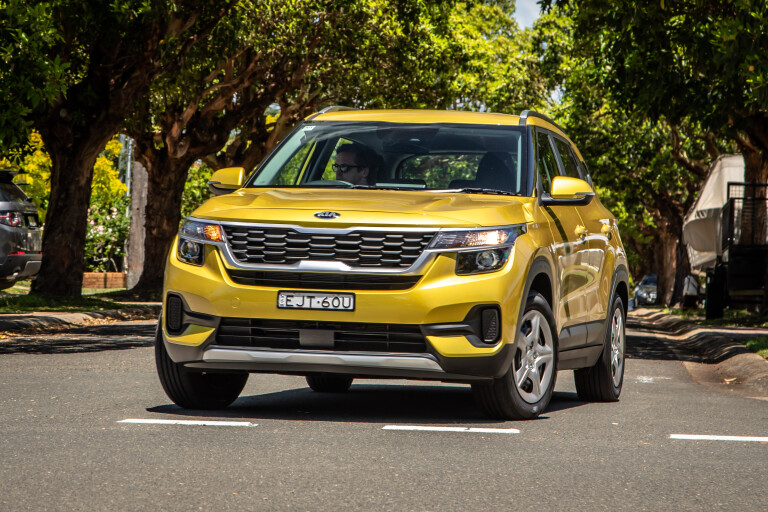
Score breakdown
Things we like
- Good chassis balance
- Tons of space
- Well-equipped
Not so much
- Unreliable wireless Apple CarPlay
- 2.0-litre engine a bit uninspiring
- Dinky steelies
- Plastic steering wheel
UPDATE, November 25, 2022: Updated 2023 Kia Seltos now in Australia
Kia's updated 2023 Kia Seltos range is now in Australia, and we've driven it. Get the full story, and video, at the link below.
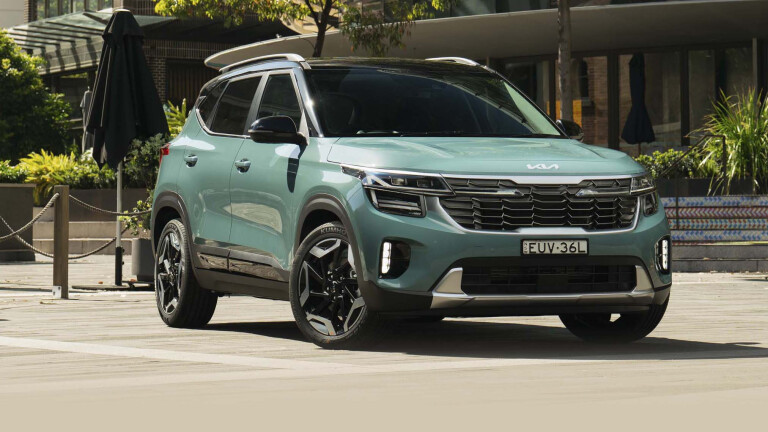
Story continues: 2021 Seltos S review
Kia’s Seltos arrived here just before COVID and a good thing it did too. It plugged one of a couple of Kia’s SUV gaps (the other later filled by the Stonic) and set the company on its style-led path in the SUV marketplace.
Getting one at the moment is extremely tricky because dealers are selling them months ahead as its popularity mixes with its semiconductor-shortage-and-lockdown-driven scarcity.
The Seltos is part of a fiercely competitive segment, with everyone having a go. It’s even one of the few segments that offers petrol, hybrid, plug-in hybrid and full EV options to eke out a few more nameplate sales.
Usually, only the posh SUV segment can offer that kind of powertrain diversity and Kia is responsible for a good chunk of the variety for mainstream buyers when you consider its range of electrified Niros.
As entry-level model of the range, the Kia Seltos S is still exceptional value and upon arrival turned quite a few heads. Not many makers have the audacity to fit steel wheels that disappear into big wheelarches, but Kia did it and made sure you noticed by making the only free colour a near fluorescent yellow.
The thing is – and this is unusual for a Kia – the very carefully designed spec seems a bit skinny. Let’s find out how skinny and whether it even matters.
Editor's note: This review was produced before new Seltos stock arrived in Australia with Kia's refreshed logo.
Pricing and Features
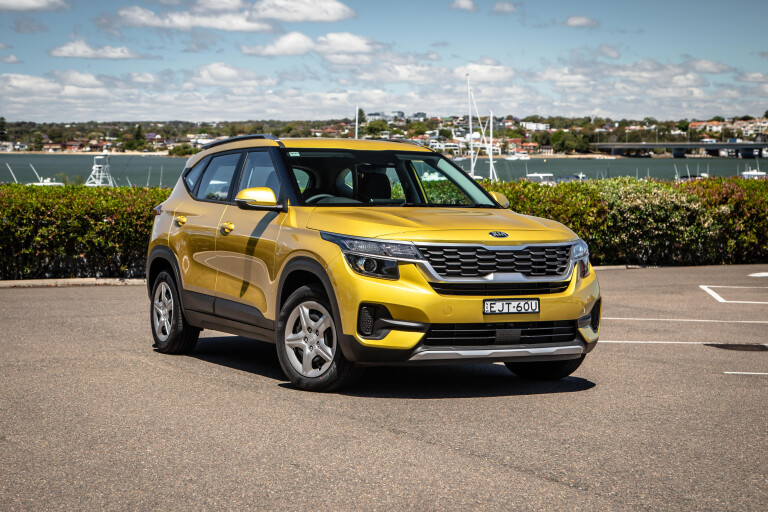
Despite a couple of price rises since its debut in Australia, the starting price for a Kia Seltos S is still very competitive, coming in at $26,790 before on-road costs. However, if you’ll permit me, you’re a mug if you buy it at that price without first ticking the Safety Pack option box, which brings us to $27,790 +ORC; a grand well spent in the name of safety.
At the time of writing, the S and S with Safety Pack both snuck in under the $30,000 psychological barrier, with drive-away pricing well south of that mark. It’s a lot of car for the money if you’re prepared for a couple of exclusions.
That’s not to say it’s sparse for the money, far from it. I quite like the cloth interior of the basic Seltos, which comes with cruise control, 8.0-inch touchscreen, six speakers, power windows and mirrors, remote central locking, air-conditioning, rear parking sensors, reversing camera and, er, not a lot else. But at this price level, you can’t expect too much. Importantly, you’re not missing anything particularly important, though. That’s what’s clever about it.
You have to twist the key in the ignition to start and live with single-zone climate control as though dual-zone is particularly effective in all but the very expensive cars on sale today. You do miss out on rear air vents, though, which I find particularly annoying.

The 16-inch steel wheels look hilariously dinky, although my sense of humour failed somewhat when my palm was reacquainted with the polyurethane steering wheel. I mean, yes, I’m spoilt, but it’s not a nice wheel and feels like it’s out of a van. You’re also stuck with halogen headlights, although that’s true for all but the GT-Line.
The touchscreen runs an easy to use if monochromatic media system that includes wireless Apple CarPlay (that sometimes refuses to work) and wireless Android Auto, neither of which are available with the larger screen on models further up the range for various tedious reasons.
Given my experience with CarPlay, the USB version might be preferable. The reliability of the wireless connectivity is more of an issue given there’s no sat-nav.
Five-star ANCAP safety (tested in 2019) is available across the range. The basic set-up on the S arrives with the usual six airbags, ABS, stability and traction controls, lane-keep assist, driver attention alert and forward AEB with pedestrian detection.
At this price level, you can’t expect too much. Importantly, you’re not missing anything particularly important, though. That’s what’s clever about it.

The thousand-dollar Safety Pack adds in driver attention alert with leading vehicle departure alert (aka “Stop looking at your phone and drive!”), forward AEB and collision warning with added cyclist detection and junction assist (which stops you from turning across approaching traffic).
The kids are looked after with two ISOFIX and three top-tether anchors.
Another bugbear of mine is the absence of reverse cross-traffic alert. I think all cars should have this because it saves a lot of stupid little accidents that eat into your motoring life and give your insurance company an excuse to charge you more.
Only the Sport+ and GT-Line score reverse cross-traffic alert, reverse AEB and blind-spot monitoring.
Besides the Safety Pack, there are precisely zero factory options apart from the paint. You can choose the post-Berocca pee colour – Starbright Yellow – or Cherry Black, Snow White Pearl, Steel Grey, Gravity Grey, Mars Orange or Neptune Blue.
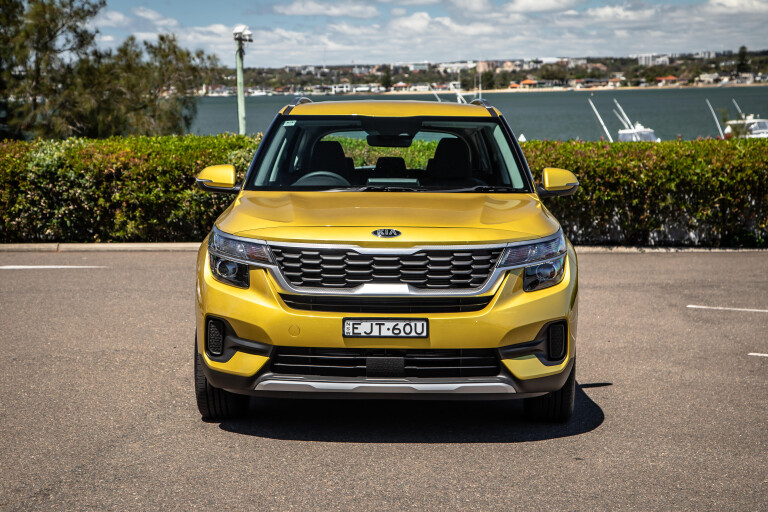
All but the yellow carry a $520 extra charge. I’d still choose the Safety Pack over a different colour because let’s face it, you’re not going to lose this machine nor will others have trouble seeing it.
There are a number of cars available at or around this price (the following prices are before on-roads). The entry-level Hyundai Kona starts at $26,600 with an almost identical drivetrain, you can have a Suzuki Vitara manual for $26,990 with a gasping 1.6-litre engine (another grand for the auto).
The Mazda CX-3 is also around that price in a one-from the bottom spec (albeit much smaller) and pretty much everything worth talking about in the same breath is over $30,000.
I nearly forgot the Mitsubishi ASX, which is still a very strong seller given its advancing age and ho-hum everything. It’s similar in size to the Kia but isn’t from the same decade (apart from the nose), costing $26,240.
Comfort and space
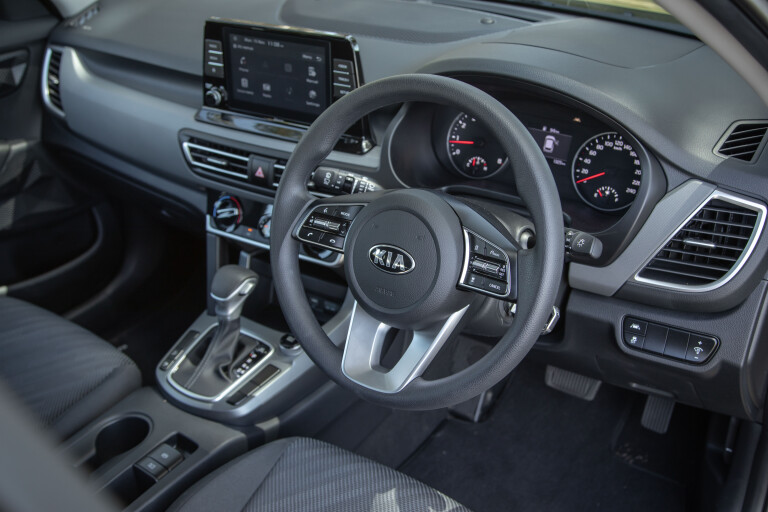
The Seltos is a big unit for the class, almost as long as the outgoing version of its bigger sibling, the Sportage. It’s very roomy inside, with plenty of head and legroom front and rear.
There are further sacrifices to make the price and those are borne by the rear seat occupants. No armrest, no cup holders, no USB, no rear air vents – it’s a tad grim back here.
You do get bottle holders, though, so that’s some consolation. You could get three across at a pinch, though, as the transmission tunnel isn’t too high and feet can go under the front seats because they’re set reasonably high.
There are further sacrifices to make the price and those are borne by the rear seat occupants. No armrest, no rear air vents ... You do get bottle holders, though.
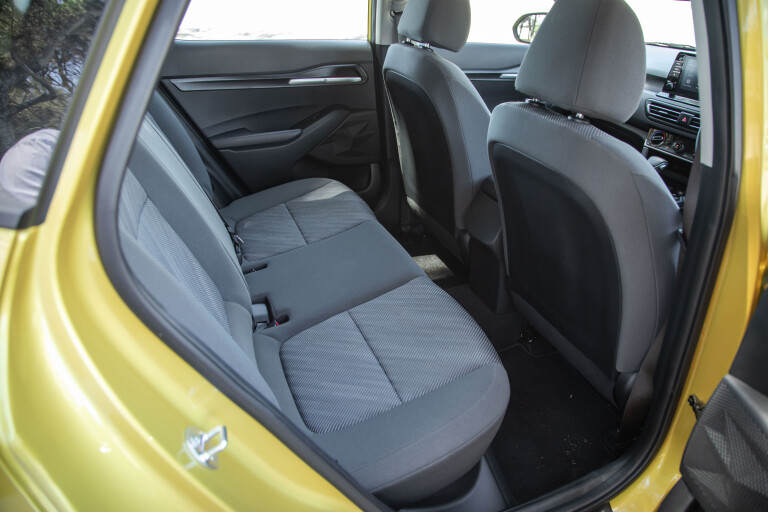
Also useful are the rear door apertures, which are huge for the car’s size, allowing easy ingress and egress as well as loading and unloading of kids in capsules or car seats.
The boot carries a whopping 498 litres with the seats up and when you put them down, you have 1428 litres to fill.
As well as being big, the load space is quite wide and very flat, meaning items slide in and out of the boot with ease.
On the road
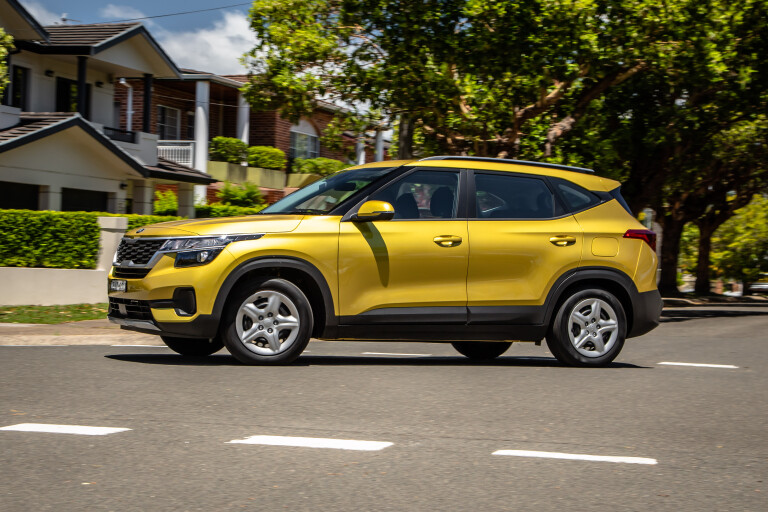
The Seltos range, sharing much of its underguts with the Hyundai Kona, has two choices of engine. Down here in the cheap(er) seats, it’s the 2.0-litre MPI petrol that has been with us since the car’s launch. As it is also in the Cerato, it is pretty much as you might expect – good enough for the job.
The MPI spins up 110kW at 6200rpm and a fairly weak 180Nm at 4500rpm to drag its 1355kg tare weight along. Normally that would be a cause for concern. I’m going to present you with another cause for concern – the front wheels are driven by an automatic continuously variable transmission (CVT). Shocking enough on its own but it turns out to be a good transmission.
Not merely “not bad for a CVT”, but an actual good transmission.
CVTs work well in low torque applications and this certainly fits the bill when you apply the Nm-to-weight equation. Compact SUVs all seem to have around 100kW and around 200Nm of torque, so Kia is giving with one hand and taking with another here.
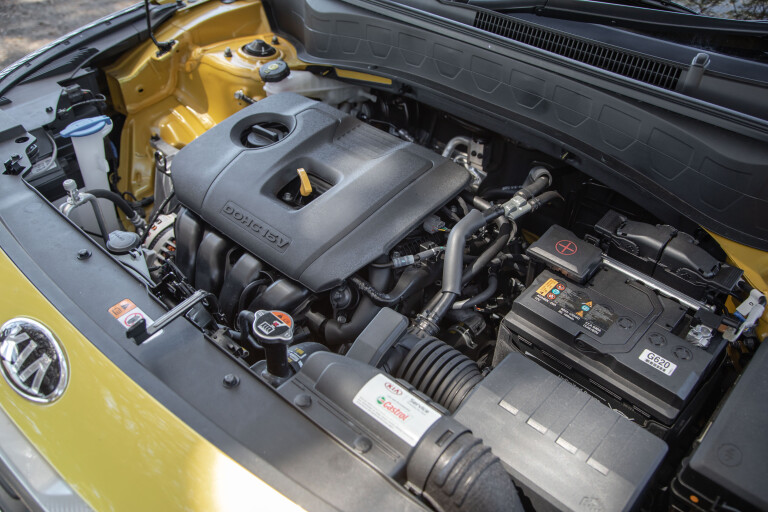
Take-up from the gearbox is swift to the point of aggressive, meaning you get a good shove when you ask for acceleration, rather than the usual wake-up-and-yawn of a typical CVT. The engine sound is damped down enough for you to have to remind yourself that this is a CVT, too, which I am led to believe is not something normal people feel compelled to do.
Similarly, normal people don’t feel compelled to hustle a large-ish compact SUV riding on 16-inch steelies and 60-section tyres, but as ever, this is something that is worth doing to weed out any bad behaviour.
The usual MacPherson strut front is joined by a coupled torsion beam rear. As with its Korean cousin, the Seltos manages all but one per cent of the daily grind without the usual crashiness of a torsion beam rear end. Or, curiously, a multi-link rear end from Mitsubishi.
Overall, the Seltos is well-damped and body roll kept well in check, even during enthusiastic cornering.
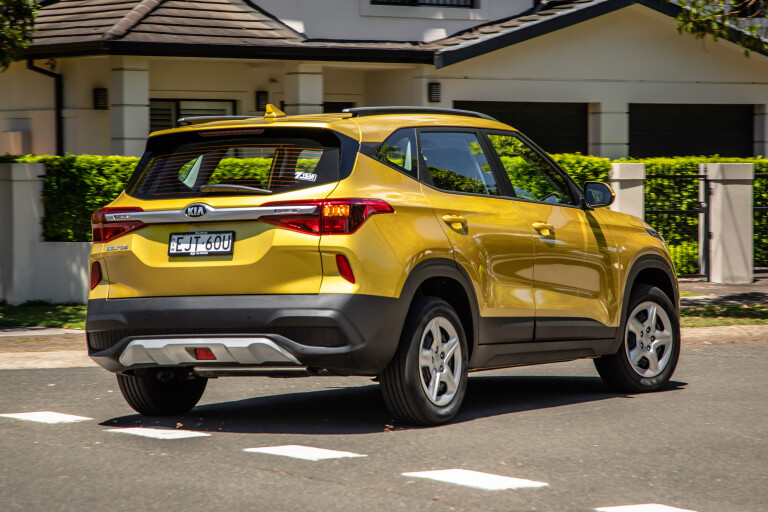
Overall, the Seltos is well-damped and body roll kept well in check, even during enthusiastic cornering. Perhaps by design, the tyres are the first things to give up when you’re having a bit of a laugh, which is entirely predictable and comes with plenty of sad-sounding noise.
It is, however, very easy to bring back into line with the usual stability control systems stepping in if having a laugh turns into having a moment.
The balloon-like tyres are perhaps the key to the Seltos’ urban appeal. Those Everest-like sidewalls dwarf the wheel covers but also soak up anything Sydney’s broken bitumen can throw at them, haughtily shrugging off all but the worst excesses this benighted city could come up with.
As ever, the sound deadening was roundly defeated by the dreadful surface of the M4 motorway, but the rest of the time it was quiet and very pleasant in the lofty cabin.
Ownership
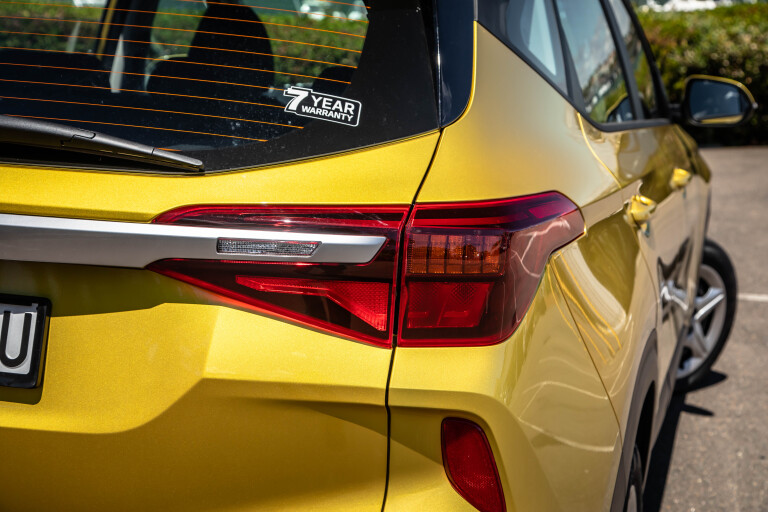
The Seltos comes with Kia’s pace-setting seven-year warranty with unlimited kilometres, chucking roadside assist into the bargain.
Its capped-price servicing regime also applies, covering the first seven services up to seven years or 105,000km, translating to a 12 month/15,000km service interval.
The prices move around a bit, with the first hitting you for $261 and alternating between big rises and nearly equal falls for a total of $2818 over seven services, or an average of $402 per service.
That’s more than a Toyota C-HR but competitive with most other brands in this space. A turbo 1.6 Seltos will cost you $3214 over the same period.
VERDICT

The Seltos S isn’t the one you want if you have more money to spend but it’s a lot of car for the money if you need something roomy, reliable and dependable. It’s not a bad inner-city car, given you won’t have to care too much about scraping hubcaps against gutters.
If you have extra to spend, spend it because you get all this and lots more in the higher variants although for some reason Kia is resistant to fitting LED headlights until you reach the fifteen grand more-expensive GT-Line. And at the risk of gratuitous repetition, make sure you get that extra Safety Pack, because it’s worth it.
The Seltos S isn’t the one you want if you have more money to spend but it’s a lot of car for the money if you need something roomy, reliable and dependable.
2021 Kia Seltos S specifications
| Body: | Five-door compact SUV |
|---|---|
| Drive: | FWD |
| Engine: | 2.0-litre four-cylinder naturally aspirated |
| Transmission: | CVT |
| Power: | 110kW @ 6200rpm |
| Torque: | 180Nm @ 4500rpm |
| Bore stroke (mm): | 81 x 97 |
| Compression ratio: | 12.5 : 1.0 |
| 0-100km/h: | 10 sec (estimate) |
| Fuel consumption: | 6.8L/100km (combined) |
| Weight: | 1355kg |
| Suspension: | MacPherson struts front / coupled torsion beams rear |
| L/W/H: | 4370mm/1800mm/1615mm |
| Wheelbase: | 2630mm |
| Brakes: | 280mm ventilated disc front / 262mm solid disc rear |
| Tyres: | 205/60 R16 Kumho Ecsta |
| Wheels: | 16-inch steel wheels (spae-saver spare) |
| Price: | $26,790 + ORC |
Score breakdown
Things we like
- Good chassis balance
- Tons of space
- Well-equipped
Not so much
- Unreliable wireless Apple CarPlay
- 2.0-litre engine a bit uninspiring
- Dinky steelies
- Plastic steering wheel



COMMENTS